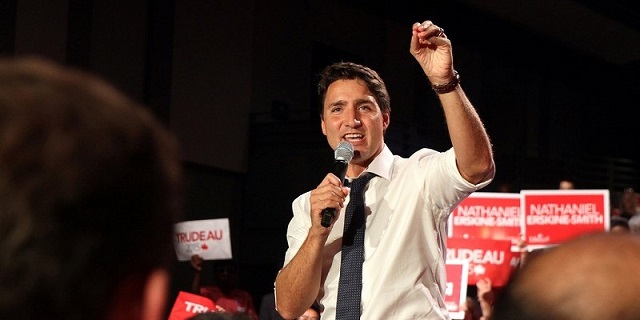Business
Federal government clearly misstates its economic record

From the Fraser Institute
“since 2015 Canada has posted some of the weakest economic growth numbers, measured on a per-person basis, in half a century”
“Denominator blindness” refers to situations where people fail to put what seem to be big numbers into proper context. The affliction is especially common among governments seeking to justify their spending and other policy decisions. In Canada, denominator blindness has become a central feature of the narratives peddled by many politicians.
For example, the Trudeau government’s recent economic update, which includes a forward by Finance Minister Chrystia Freeland where she notes that the International Monetary Fund expects Canada to have “the strongest economic growth in the G7 next year.” She also insists her government is fostering economic growth that “creates middle class jobs, raises incomes, and makes middle class communities more prosperous.”
Both claims lack context and misstate the government’s economic record.
Prosperity is measured using both a numerator, typically the amount of output the economy produces in a year, and a denominator, the size of the population. A larger population means the economic pie must be divided into more slices to estimate how much “output” is available to the average resident. With a rapidly expanding population, the economy must generate a lot more output merely to stop the individual pie slices from shrinking.
Minister Freeland is correct that Canada’s economy has been growing, both since the worst of the COVID shock in late-2020/early-2021 and over the period when the Trudeau government has been in power. But she ignores the bigger picture, which shows two important things.
First, since 2015 Canada has posted some of the weakest economic growth numbers, measured on a per-person basis, in half a century. The pattern of feeble economic growth was evident before the onset of COVID.
Second, Canada is among the few advanced economies where output or gross domestic product (GDP) per person in 2023 has still not returned to pre-pandemic levels. In part, this reflects surging population growth, which affects the denominator that helps determine whether economic growth is producing gains in average incomes and living standards. In Canada’s case, modest economic growth combined with a skyrocketing population has resulted in a multi-year decline in per-person income and erosion of overall prosperity. Adjusted for inflation, GDP per person is still 2 per cent lower than in 2019.
Denominator blindness also characterizes recent attempts by the federal, Ontario and Quebec governments to explain why they’re allocating up to $50 billion in subsidies and tax incentives to lure a handful of electric vehicle battery manufacturers to Canada. The politicians making these decisions point to the several thousand jobs the EV manufacturing facilities will support once they are fully operational. But they won’t discuss how this fits within the larger job market.
Total employment in Canada is 20.1 million, with almost 1.8 million jobs in manufacturing. The vast sums being thrown at EV battery manufacturers will have essentially no impact on the aggregate job numbers and barely make a ripple, even in the manufacturing sector. Moreover, not all the promised EV jobs will be “new” positions—many workers attracted to the EV industry will likely be drawn from other businesses, worsening skill shortages that are plaguing Canadian manufacturers.
Perhaps aspiring politicians should be required to study the basic arithmetic of fractions before they run for office.
Author:
Business
What Do Loyalty Rewards Programs Cost Us?

You’ve certainly been asked (begged!) to join up for at least one loyalty “points” program – like PC Optimum, Aeroplan, or Hilton Honors – over the years. And the odds are that you’re currently signed up for at least one of them. In fact, the average person apparently belongs to at no less than 14 programs. Although, ironically, you’ll need to sign up to an online equivalent of a loyalty program to read the source for that number.
Well all that warm, fuzzy “belonging” comes with some serious down sides. Let’s see how much they might cost us.
To be sure, there’s real money involved here. Canadians redeem at least two billion dollars in program rewards each year, and payouts will often represent between one and ten percent of the original purchase value.
At the same time, it’s estimated that there could be tens of billions of unredeemed dollars due to expirations, shifting program terms, and simple neglect. So getting your goodies isn’t automatic.
The Audit is a reader-supported publication.
To receive new posts and support my work, consider becoming a free or paid subscriber.
Just why do consumer-facing corporations agree to give away so much money in the fist place?
As you probably already know, it’s about your data. Businesses are willing to pay cold, hard cash in exchange for detailed descriptions of your age, sex, ethnicity, wealth, location, employment status, hobbies, preferences, medical conditions, political leanings, and, of course, shopping habits.
Don’t believe it works? So then why, after all these years, are points programs still giving away billions of dollars?
Every time you participate in such a program, the data associated with that activity will be collected and aggregated along with everything else known about you. It’s more than likely that points-based data is being combined with everything connected to your mobile phone account, email addresses, credit cards, provincial health card, and – possibly – your Social Insurance number. The depth and accuracy of your digital profile improves daily.
What happens to all that data? A lot of it is shared with – or sold to – partners or affiliates for marketing purposes. Some of it is accidentally (or intentionally) leaked to organized criminal gangs driving call center-related scams. But it’s all about getting to know you better in ways that maximize someone’s profits.
One truly scary way this data is used involves surveillance pricing (also known as price discrimination) – particularly as it’s described in a recent post by Professor Sylvain Charlebois.
The idea is that retailers will use your digital profile to adjust the prices you pay at the cash register or when you’re shopping online. The more loyal you are as a customer, the more you’ll pay. That’s because regular (“loyal”) customers are already reliable revenue sources. Companies don’t need to spend anything to build a relationship with you. But they’re more than willing to give up a few percentage points to gain new friends.
I’m not talking about the kind of price discrimination that might lead to higher prices for sales in, say, urban locations to account for higher real estate and transportation costs. Those are just normal business decisions.
What Professor Charlebois described is two customers paying different prices for the same items in the same stores. In fact, a recent Consumer Reports experiment in the U.S. involving 437 shoppers in four cities found the practice to be quite common.
But the nasty bit here is that there’s growing evidence that retailers are using surveillance pricing in grocery stores for basic food items. Extrapolating from the Consumer Reports study, such pricing could be adding $1,200 annually to a typical family’s spending on basic groceries.
I’m not sure what the solution is. It’s way too late to “unenroll” from our loyalty accounts. And government intervention would probably just end up making things worse.
But perhaps getting the word out about what’s happening could spark justified mistrust in the big retailers. No retailer enjoys dealing with grumpy customers.
Be grumpy.
The Audit is a reader-supported publication.
To receive new posts and support my work, consider becoming a free or paid subscriber.
Business
Largest fraud in US history? Independent Journalist visits numerous daycare centres with no children, revealing massive scam

A young journalist has uncovered perhaps the largest fraud scheme in US history.
He certainly isn’t a polished reporter with many years of experience, but 23 year old independent journalist Nick Shirley seems to be getting the job done. Shirley has released an incredible video which appears to outline fraud after fraud after fraud in what appears to be a massive taxpayer funded scheme involving up to $9 Billion Dollars.
In one day of traveling around Minneapolis-St. Paul, Shirley appears to uncover over $100 million in fraudulent operations.
🚨 Here is the full 42 minutes of my crew and I exposing Minnesota fraud, this might be my most important work yet. We uncovered over $110,000,000 in ONE day. Like it and share it around like wildfire! Its time to hold these corrupt politicians and fraudsters accountable
We ALL… pic.twitter.com/E3Penx2o7a
— Nick shirley (@nickshirleyy) December 26, 2025
-

 Business1 day ago
Business1 day ago“Magnitude cannot be overstated”: Minnesota aid scam may reach $9 billion
-

 Haultain Research6 hours ago
Haultain Research6 hours agoSweden Fixed What Canada Won’t Even Name
-

 Business1 day ago
Business1 day agoLargest fraud in US history? Independent Journalist visits numerous daycare centres with no children, revealing massive scam
-

 Censorship Industrial Complex1 day ago
Censorship Industrial Complex1 day agoUS Under Secretary of State Slams UK and EU Over Online Speech Regulation, Announces Release of Files on Past Censorship Efforts
-

 Business6 hours ago
Business6 hours agoWhat Do Loyalty Rewards Programs Cost Us?
-

 Daily Caller2 days ago
Daily Caller2 days agoIs Ukraine Peace Deal Doomed Before Zelenskyy And Trump Even Meet At Mar-A-Lago?









